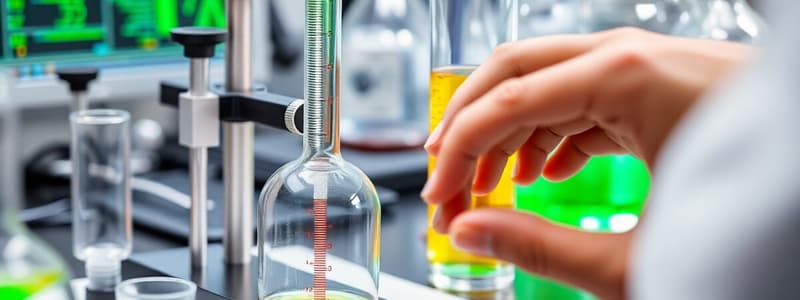Podcast
Questions and Answers
Which of the following is NOT a part of the atom?
Which of the following is NOT a part of the atom?
- Proton
- Molecule (correct)
- Nucleus
- Neutron
What do you call the changing of a substance into one or more different substances?
What do you call the changing of a substance into one or more different substances?
- Chemical change (correct)
- Decomposition
- Physical change
- Phase change
What term describes the energy required to remove an electron from an atom?
What term describes the energy required to remove an electron from an atom?
- Electron affinity
- Ionization energy (correct)
- Electronegativity
- Atomic radius
Which of these is a property of both ionic and covalent compounds?
Which of these is a property of both ionic and covalent compounds?
Which of the following methods is used to separate mixtures based on differences in boiling points?
Which of the following methods is used to separate mixtures based on differences in boiling points?
Flashcards
What is an atom?
What is an atom?
The smallest unit of matter that retains the properties of the element; composed of electrons, protons, and neutrons.
Chemical Change
Chemical Change
A change in the composition of matter; new substances with different properties are formed.
What is the atomic number?
What is the atomic number?
The number of protons in the nucleus of an atom; determines the element's identity.
Covalent Bonding
Covalent Bonding
Signup and view all the flashcards
What is a Lewis Structure?
What is a Lewis Structure?
Signup and view all the flashcards
Study Notes
Lab Skills and Measurements
- Data collection is crucial in experiments.
- Sources of error are inherent in any measurement process. Understanding them is vital for improved accuracy.
- Percent error quantifies the difference between measured and accepted values. Standard deviation indicates data spread and variability.
- Significant figures reflect the precision of measurements. Rules for determining them are essential.
- Accurate measurement is fundamental in science. Understanding various units and their conversions is important.
- Dimensional analysis is a method for converting units. Proper conversion factors ensure accurate results.
Matter
- Matter is anything that has mass and takes up space.
- Properties of matter can be categorized as physical or chemical.
- Physical changes alter a substance's appearance without changing its chemical composition. Examples of physical changes include dissolving sugar in water or cutting paper.
- Chemical changes alter a substance's composition, producing new substances. Recognizing evidence of a chemical change is critical. Examples include burning wood or rust.
- Matter is categorized as elements, compounds, or mixtures. Understanding these classifications is vital.
- Methods for separating mixtures (e.g., filtration, distillation) are critical in chemistry.
The Atom
- Democritus and Dalton contributed to the understanding of the atom. Dalton's atomic theory is a cornerstone.
- Key laws of matter relevant to atomic structure, like the law of definite proportions, conservation of mass, and multiple proportions are crucial for understanding atomic behavior.
- Thomson's model and Rutherford's model have helped us refine our view of atomic structure.
- Atoms consist of protons, neutrons, and electrons. Fundamental understanding of subatomic particles is essential.
- Mass number, atomic mass, and atomic weight are measures of the atom's mass.
- Isotopes are atoms of the same element but with different numbers of neutrons. Isotopes have important properties and applications.
Light and Electrons
- Electromagnetic radiation has wave-like and particle-like properties. Understanding these properties is important.
- Bohr's model of the atom contributed to the understanding of quantized energy levels.
- Energy levels are discrete energy states in an atom. Knowledge of electron transitions between these energy levels is important to understand light absorption/emission.
- Schrodinger's equation describes electron behavior in an atom. Electron states, or atomic orbitals, are described in quantum mechanical terms.
- Filling atomic orbitals follows the Aufbau principle, Hund's rule, and the Pauli exclusion principle. Electron configuration depicts the arrangement of electrons in orbitals for an element.
The Periodic Table
- The periodic table is an arrangement of elements. Its development, driven by periodic trends, is vital for understanding elemental properties.
- The organization of the periodic table provides information like atomic number, elemental symbol, and atomic mass.
- Groups on the periodic table exhibit similar chemical properties. These properties are key to understanding reactivity.
- Periodic trends like effective nuclear charge, atomic radius, and ionization energy help predict and explain element properties.
Naming Compounds
- Electronegativity values determine the type of bonds formed.
- Formation of ions (cations and anions) is crucial for ionic compounds' structure and bonding.
- Naming ionic compounds follows specific rules.
- Naming covalent compounds requires understanding prefixes and suffixes.
Chemical Bonding
- Ionic compounds are formed through electrostatic attraction.
- Lewis structures visually represent bonding in ionic compounds.
- Covalent compounds are formed by sharing electrons. Lewis structures depict shared electrons in covalent bonds.
- VSEPR theory predicts molecular shapes based on electron pair repulsion.
- Polarity results from unequal electron sharing and plays a role in molecular interactions.
Chemical Reactions
- Types of chemical reactions (e.g., synthesis, decomposition, single displacement) are key for predicting product formation.
- Predicting products and balancing chemical equations are fundamental to stoichiometry problems.
The Mole
- The mole is the SI unit for amount of substance.
- Molar mass is the mass of one mole of a substance. Calculating molar mass is important for various stoichiometric calculations.
- Converting between grams, particles, and moles of a substance is vital skill in chemistry. Understanding these conversions.
- Percent composition defines the percentage of each element in a compound.
Stoichiometry
- Calculating amounts of product using chemical equations and information about reactants is called stoichiometry.
- Limiting and excess reagents determine the maximum amount of product formed.
- Percent yield compares the actual yield of a reaction to the theoretical yield.
Studying That Suits You
Use AI to generate personalized quizzes and flashcards to suit your learning preferences.




